From 2GreenEnergy Intern Olivier Goavec: The Long-Term Prospect for Powering the Entire Continent of Europe with Huge CSP Arrays in Northern Africa
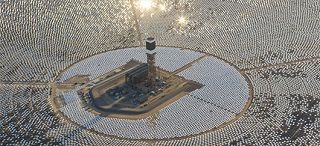
The Technology in DESERTEC’s Project:
Originally DESERTEC’s project had been designed to feed Africa and a part of Europe with electricity (15% by 2050), representing a 700Twh importation per year. That figure is more than the consumption of Germany, the most populous country in Europe with 80 million inhabitants and 600Twh consumption.
The idea is to install solar plants in the Northern Sahara and the Middle East — not solar photovoltaic panels, but solar thermal / concentrated solar power (CSP). This technology uses the sun to heat a liquid, in this case, water. Those who played with their magnifying glass to roast ants know how powerful this can be. It is the same principle with CSP; we concentrate the solar beam power, by means of mirrors, onto one common point or line, to heat a liquid. After that, CSP works like a classic electrical power plant; the water becomes steam which turns a turbine which drives a generator to produce electricity.
Here is the implementation of the power plant design at the beginning of the project:
There are different types of CSP. Solar towers deploy thousands of mirrors all around a tower, at the top of which a water reservoir is heated. The Ivanpah solar power facility in the U.S. is a good example; inaugurated in February 2014, this CSP power plant is the largest in the world (173,500 mirrors creating 392 MW on a 4000-acre tract).
Ivanpah solar power facility
The most common technology to date is parabolic trough, in which a fluid flows through a tube, generally black to absorb a maximum of power, which is heated to almost 500°C.
Parabolic trough, Andasol, Spain
In both cases, mirrors follow the sun to improve efficiency. Other kinds of technology exist but they are not of sufficient interest to enable me to develop them in this paper. One of the big advantages of the CSP concept lies in the fact that the heat can be easily stored in large quantity; it allows the production of electricity 24/7, even after sunset and on cloudy days.
Once we have the electricity in Africa, we still need to bring it back to Europe. For that, scientists suggest setting up high-voltage direct current transmission lines, or HVDC, to link the two continents. The choice of that technology is simple: if we want to transport current over long distances, we will have lower losses in DC than in AC. This is because with AC we will produce reactive power in our transmission lines due to the capacitors and inductors present in the cable. Their impedance depends on the frequency, which is absent in DC. That reactive power produces an extra current which increase losses. HCDC lines could transport electricity with losses near to 3% per 1000km.
However, HVDC transmission lines are not so easy to implement. We need a strong power electronics system to convert AC current to DC and transport the electricity at nearly 1MV. The line must be underwater which complicates the installation and necessitates the utilization of special vessels; this is not economical.
To get an idea of DESERTEC’s ambition, there are no fewer than 15.000 km² of mirrors and 20 HVDC transmission lines from which 5GW is expected.
The Sahara
The Sahara is the biggest desert in the world; it covers an area close to 9,400,000 km² and encompasses 11 countries: Algeria, Morocco, Libya, Mauritania, Tunisia, Egypt, Mali, Niger, Chad, and Sudan. Its average sunshine varies between 3000 and 4300h a year out of 4800 possible. Winters are mild, with temperatures up to 25°C (77°F) and summers are brutal with temperatures up to 50°C (122°F). The Sahara is a huge reserve of power and at only a few hundred kilometers to the south of Europe, it is almost empty; just five million people are living here representing less than two inhabitants per km². At first glance, its exploitation should be easy, but many obstacles slow down the project and could kill it.
Main Problems with DESERTEC’s project
One of the biggest problems in DESERTEC’s project is the multitude of countries that share the Sahara. Each country has its own approach to renewable energy and towards dealing with Europe. Many Africans do not view the project happily. Indeed, even if it can be profitable to their economy with the creation of jobs, it is also seen by many Africans as exploitation, a reprise of the colonial days. Moreover, unlike Europe, Africa is growing rapidly and needs more power to feed its needs. Also, many questions loom: who will own the facility? What will be the feed-in tariffs? Will the market be bidirectional?
Lastly, thanks to HVDC transmission lines, the electrical current will be able to circulate on both sides; from Europe to Africa and Africa to Europe, in function of the power needed. But the paradox is that today in order to support its growth, Africa would be wrong to export its electricity to Europe. And interestingly, Europe, especially in countries like Spain, needs to reinforce its grid to integrate renewable energy from variable sources, and perhaps export some of the extra power from renewables. This is the king of all paradoxes.
Another important problem when you want to do business internationally is policy instability. Unfortunately, Africa is not what one might call a haven of peace and stability. Just look at Egypt, Libya, and Tunisia as examples; the Arab Spring of 2010 is not really over. In Egypt after the presidential election of 2012 which had seen the victory of Mohamed Morsi, another election will take place in 2014 — barely 2 years later; in 2011 Libya has also seen a revolution which has led the international community to intervene to bring peace to the country.
. Tunisia also saw a revolution in 2010. It is not possible to have a vision over the long term of an investment if the safety of the installations cannot be guaranteed, or if each successive government changes its mind about the project. On top of everything else is the risk of terrorism which is already very much present in Africa. Investors will not ignore this threat.
DESERTEC’s project also experiences difficulties in negotiation. Most of the time an interpreter is needed, which lengthens things. If you don’t speak Arabic or French in Africa, business can be difficult.
The cost of these CSP arrays has been estimated at 400 billon Euros ($549.62 billion). That represents an amount of about $15.3 billion per year till 2050, the supposed end of the complete project. But to date the concept is in trouble; after the Eurozone crisis started in 2010 with the Greek debt and the slowness of the project some historical investors are leaving, like Siemens and Bosch.
Last but not least, in the Sahara there is a lot of dust and CSP arrays needs to be clean to work efficiently. Of course the best way to clean the mirrors is with water, but this is problematic in a desert, where water is a rare gift not to be wasted. Thus to solve the problem, DESERTEC wants to install a desalination plant.
Unfortunately the project which had generated enthusiasm in 2009 can’t really pretend anymore to meet its objective of 15% of Europe’s electricity production by 2050. The causes are the Arab Spring, European debt crisis, and the DESERTEC foundation itself, which launched the project even before it had talks with all the concerned countries. Nevertheless, even if the project were too big to be easily implemented, all is not lost. Indeed Morocco is still interested in a CSP array and would like to invest in this technology. DESERTEC also led to smaller projects, much more realizable and a bit less geocentric. We can point to the Transgreen project which wants to promote renewables in Africa, but above all, if successful, Transgreen would mean the creation of an HVDC transmission line to connect both continents. As of today, only two electrical links exist between Europe and Africa located between Spain and Morocco.
The DESERTEC concept has inspired, and maybe revolutionized the approach that this part of the world has toward energy. Today specialists pointed out that it would be interesting to transport the idea to the western Balkans, where countries like Albania, Bosnia Herzegovina, Croatia, Kosovo, Macedonia, Montenegro and Serbia have perfect weather conditions, stable policies, and have already started the production of CSP. It would be easier and faster to invest here; it would require only modest resources to improve upon electrical connections which already exist. Such a project would be quite economical when compared to DESERTEC. In 2005 the layout of the second subsea cable between Spain and Morocco had cost 115 million Euros; imagine the cost of 20 transmission lines, nearly 10 years after.
The western Balkans:
To conclude, we can say that DESERTEC’s project is surely a brilliant idea but, unfortunately, all the required conditions are not met. The region is too unstable to have a good vision over the long term, and the costs are too high. We certainly need to develop cooperation between the energy companies of both continents, and having a Mediterranean electricity market is a requirement to securing the grid. But it would be wise not to focus only on renewables at this time, even if countries like Morocco show a strong desire to implement sustainable energy. What is also important is to understand that DESERTEC’s project can’t be realized without the support of governments from both sides; maybe that has been forgotten.
Sources:
http://www.desertec.org/ English
http://www.connaissancedesenergies.org/fiche-pedagogique/desertec French
http://www.connaissancedesenergies.org/fiche-pedagogique/solaire-thermodynamique-concentration French
http://fr.wikipedia.org/wiki/Sahara French
http://www.greentechmedia.com/articles/read/desertec-update-funding English
http://atlismta.org/online-journals/human-security/the-desertec-mirage/ English
http://www.developpement-durable.gouv.fr/Le-projet-Transgreen-developper-l.html French
http://reneweconomy.com.au/2014/are-the-western-balkans-the-new-desertec-29580 English
http://www.euractiv.fr/energie/desertec-abandonne-ses-projets-e-news-528166 French

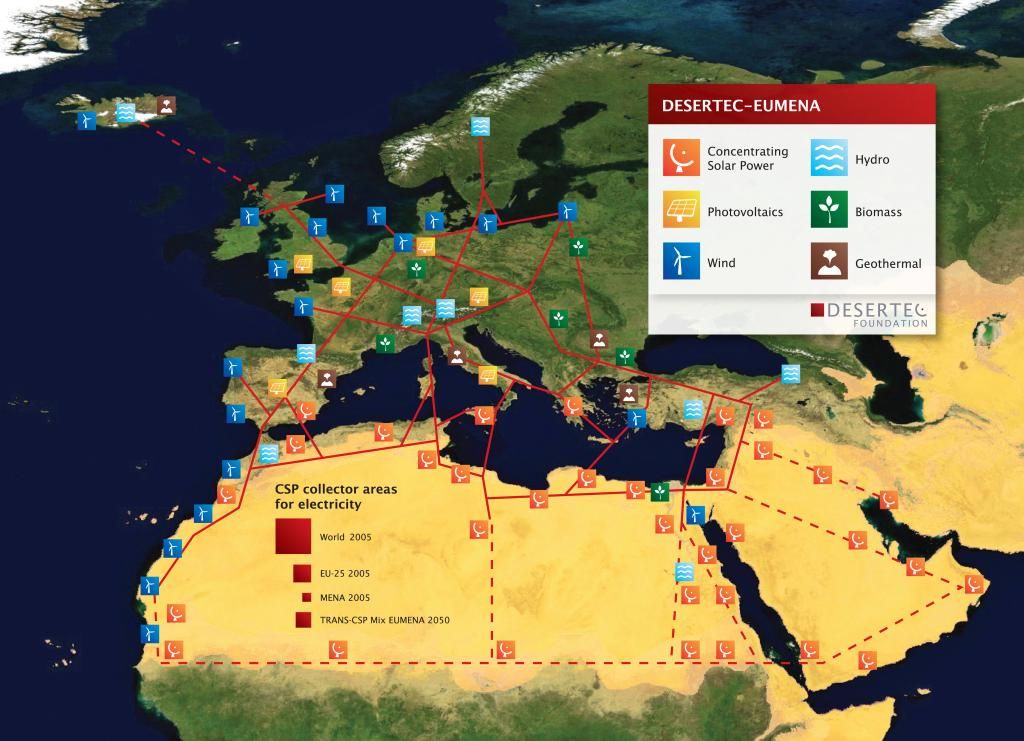
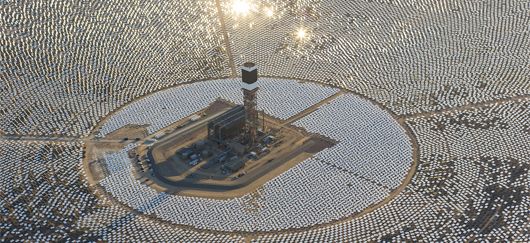
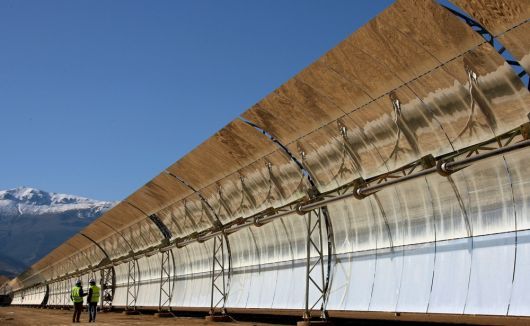
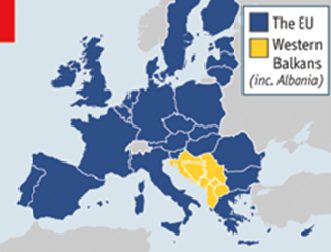
We’re paying out about $700 billion every year to unstable (and often hostile) regimes for their oil (not to mention the lethal, exorbitant and extortive cost of militarily defending our access by occupations, drones, and hundreds of foreign bases).
Alternatively, ten thousand Concentrating Solar Power (CSP) plants, each a mile square, could be dotted along our Sunbelt from Southern California to Georgia.
Using proven storage technology – such as molten salt, pumped hydro or Advanced Rail Energy Storage (ARES) – and transmitting power over High-Voltage Direct-Current (HVDC), these CSP plants will provide all the electricity currently consumed all across the entire continental US.
This system will also scale up nicely to power a new electric infrastructure for freight, as well as public and individual transportation.
That covers less than one third of a percent of the land area in the lower 48 states (about the total area of Vermont), and at $600 million per square mile, those ten thousand CSP plants will total $6 trillion, plus a few hundred billion for infrastructure improvements – that’s just about nine or ten years of our foreign oil expenses (without even mentioning military savings) – and it’ll give us a permanent system that provides cheap, clean and sustainable energy for all our electricity.
“If that’s true,” you say (and it is true), “why aren’t we doing it?”
Ask yourself why seat belts took decades to become a required standard in cars.
Ask yourself why US vehicle fuel efficiency still drags behind Japan and Europe, and we’re far behind the standards that we ourselves achieved decades ago during WWII.
American broadband speed (and coverage) is yet another example of the willful restraint of technology inflicted by entrenched vested interests.
If they make or save a buck by not doing it, they won’t do it (unless they’re forced).
The vast majority of the material needed will be concrete, steel and glass. The barriers against this elegant solution are neither technical nor resource-based, nor even financial – they’re merely political barriers that are erected by bribery, and by those intractable fossil interests that do the bribing.
Isn’t it about time We the People stood up and put an end to bribery?
Isn’t it time that we demanded the infrastructure and the technology that our advanced science and our abundant resources open to us in every facet of our lives?
“Its average sunshine varies between 3000 and 4300h a year out of 4800 possible.”
Craig Shields should try some math: 365 days x 24 hours=8760 hours. Maximum sunshine on any place of the world cannot exceed 4380 hours. 4800 hours was first mentioned in a Siemens press release in July 2009: http://www.siemens.com/press/en/pressrelease/index.php?content%5B%5D=CC&content%5B%5D=E&content%5B%5D=ES&content%5B%5D=EH&content%5B%5D=EP&content%5B%5D=ET&content%5B%5D=EW&search=desertec&date-1-dd=22&date-1-mm=04&date-1=2009&date-2-dd=22&date-2-mm=08&date-2=2009&intern=1
Siemens obvious carelessness indicates that the company never ever aimed at being serious on that. But it was a nice green-washing after several corruption scandals shattered Siemens in 2009.
I’m sure I just copied it, and didn’t redo the calculations. Thanks for the correction.
Also, I just noticed that I didn’t write this article; it came from an intern.
There’s a lot of investment and installation going on with CSP in many places across the globe – it’s working and it’s growing, and it’s here to stay – look here: http://en.wikipedia.org/wiki/List_of_solar_thermal_power_stations
Dear Colleagues,
to make sure: I am not against solar thermal power plants and also have some expertise on the subject. (Visited the Nevada plants already in 1996, followed the Desertec project and the set-up of STPPs in Spain and another one in Egypt carefully.) A successful promotion requires that all calculations are correct and no figures flawed. Unfortunately, STPP cannot compete with conventional thermal power plants as long as costs for fuel (coal, gas, oil) remain as low as they are. According to my knowledge, STPP so far are all subsidized. Another problem is the supply of cooling water. Spanish STPPs derive it from ground water. This works not forever and everywhere as capacities are limited. Air cooling significantly reduces any thermal power plants efficiency and pushes costs further up.
The overarching reason why costs for fuel (coal, gas, oil) remain as low as they have is that their respective industries have long been heavily subsidized – from direct subsidies, extraction fee and lease giveaways, and tax loopholes, to the continued permission of externalized costs like damage to human health and to biosphere health (which also impacts human health), and including as well the very design and federal support of our transportation infrastructure (which has itself been an enormous subsidy).
In comparison with all those massive and continual subsidies for toxic fossil filth, the relatively miniscule and erratic subsidies for renewables like Concentrating Solar Power (CSP) remain inadequate and ineffective at leveling the economic playing field.
Of course, add to that imbalance, the original giveaway of the very fossil resources themselves, which are the natural property of the whole people, and should always have been subject to collective decision-making in the manner of a true democratic republic.
With regard to water, I see no technical barriers to cyclic cooling systems that use a contained water supply that is neither lost, nor continually draws from external sources.
Further, the fossil competition by hydraulic fracturing (fracking) and tar sands mining and processing permanently and irredeemably poisons millions of gallons of fresh water for each well and mine – with fracking especially often in arid areas. Add to this the significant risk of those poisons escaping the well through unpredicted fractures that reach aquifers, and the risk that presents to the drinking water of millions of people.
Meanwhile, even the accused use and discard of fresh water resources by CSP returns the water to the biosphere in a form that the natural water cycle can remediate.
At bottom, the fact is that fossil filth is lethal and unsustainable, and must take its place in history, or it will make history of the stability and habitability of the only planet available to us.
As long as we keep taking prehistoric carbon out of the layers of the earth, and burning it and pouring 32 billion metric tons of CO2 yearly into the modern sky, we’ll continue to see increasingly severe consequences at both ends of the temperature scale, as well as with regard to volatile shifts in rainfall patterns (drought/flooding), and widespread lethal effects across the biosphere generally (rapidly expanding oceanic dead-zones, crop failures, mass die-offs and extinctions of vital species, etc.).
We have a very limited window of time during which we are able to transition by using some of the remaining easily and safely accessible fossil fuel (as toxic and filthy as it is) to build a clean and sustainable energy infrastructure. If that consideration isn’t part of the economic equation determining our course as a society and species, we’re headed for a cliff beyond which that transition will no longer be possible, and the damage will have been done.
Many civilizations have perished through blind and cruel devotion to monumental waste and greed. If we fail, we may not be merely the next… we may be the last.
Dear Mr. Atwood,
I agree with you regarding the huge subsidies for conventional and nuclear power generation and their hidden costs. I also agree with many other points you made.
Regarding:
“With regard to water, I see no technical barriers to cyclic cooling systems that use a contained water supply that is neither lost, nor continually draws from external sources.”
Please, look again into the details of thermal power generation. This is so far technically infeasible. If you know a way how to make this happen, please, allow the community of engineers and scientists to share your knowledge.
We are Shenzhen Shuori New Technology Co.,Ltd in China and our main products as following:
☆Solar Street Light charge Controller for VRLA battery or lithium battery (Support Data Remote Setting, PWM/MPPT Type)
☆Solar Power System charge Controller for VRLA battery (PWM / MPPT Type)
Please visit our web: http://WWW.SRNESOLAR.COM
If any models meet your demand, please feel free to contact me. Catalog & Details can be offered.
We’re sure your any inquiries or requirements will get prompt attention.
—
Best regards,
Rhean Feng
Shenzhen Shuori New Energy Technology Co., Ltd.
Address:Building B, Jianyu 2nd Industrial, Nanchang Park, Gushu, Xixiang, Baoan, Shenzhen, China Zip:518000
Mobile Phone:(+86) 18565667949/13580565572
Email: rhean@szshuori.com/rhean@srnesolar.com
Skype: rheanfeng
QQ: 2851352807
Wechat:1036342363
Website: http://www.srnesolar.com